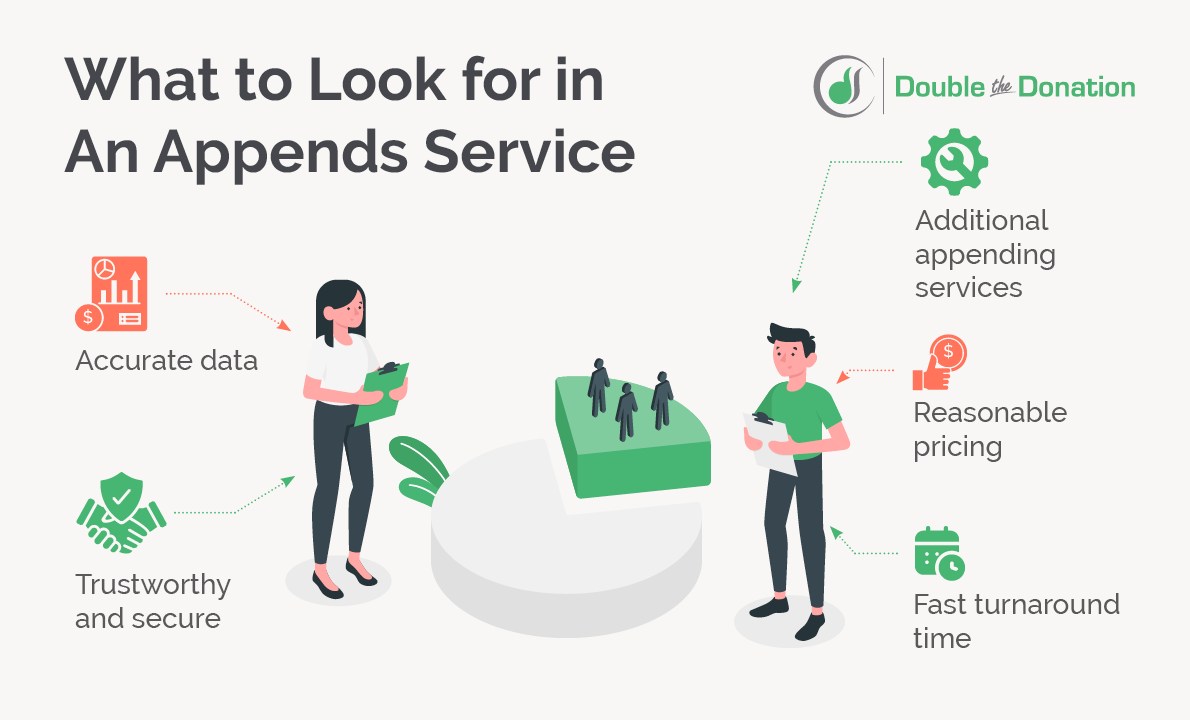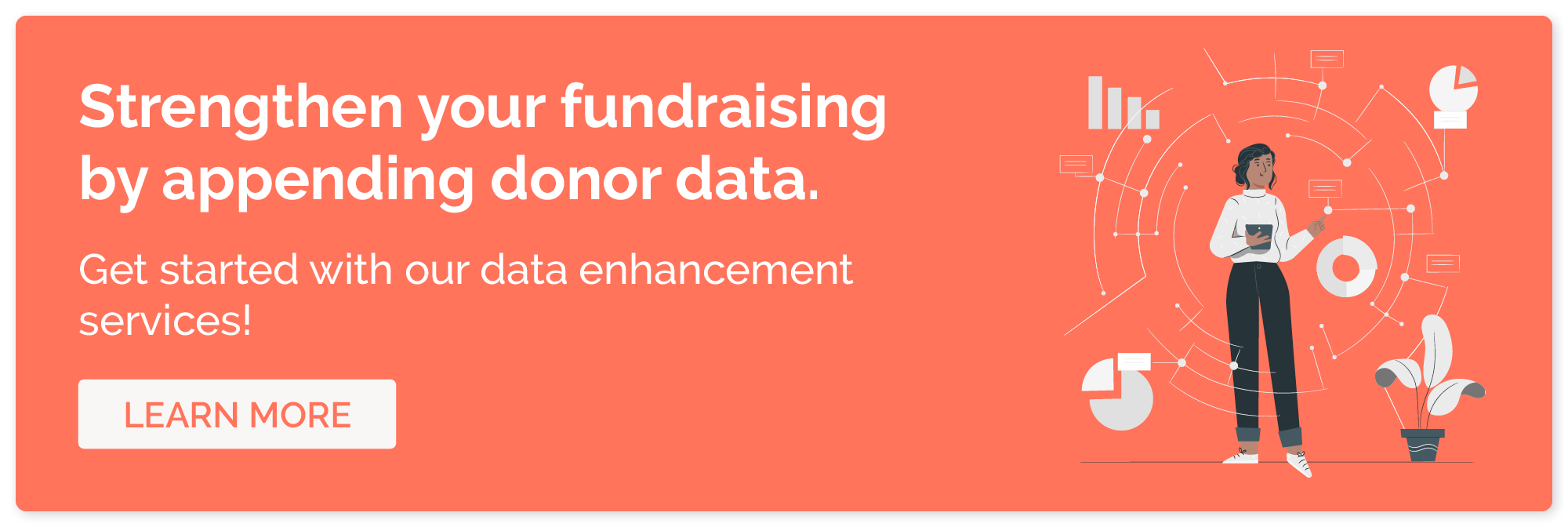Collecting data is essential for being able to contact your supporters. From giving habits to communication preferences, every piece of data you gather about your donors can be leveraged to secure gifts, earn long-term support, and expand your donor base.
One piece of basic but vital information is demographic data. From how old your supporters are to their family status to their average income, demographics help you better understand your audience. However, you may not have any natural opportunities to outright ask supporters details about their lives without coming off as invasive.
Fortunately, you can fill in missing data and correct outdated information with data appending. In this guide, we’ll take a deep dive into demographic appends and how your nonprofit can leverage them to cultivate stronger supporter relationships.
What is a data append?
“Append” means to supplement or amend something, so a “data append” is the process of supplementing and amending your nonprofit’s data. Along with demographic information, nonprofits can purchase appending services for all kinds of donor data, including:
- Email addresses
- Geographic location
- Phone numbers
- Social media profiles
- Employer data
These are just a few types of data nonprofits are likely to request to complete their donor profiles. For instance, for-profit companies often invest in customer appends related to internet search history and past purchases.
For nonprofits interested in data appending, look for services that specialize in working with nonprofit and charitable organizations. These service providers understand the unique types of supporter data that will actually be beneficial to nonprofits, so they can avoid cluttering your donor database. We’ll go over the characteristics of a reliable data append provider later.
What data is included in demographic appends?
Demographics are a catchall term for a wide variety of data, including:

- Net worth
- Age and birth date
- Gender
- Ethnicity and race
- Income
- Marital status
- Family size
- Religion
- Buying behaviors
- Hobbies and interests
This information is gathered from multiple databases the append service has access to. If you give your donors’ names and email addresses to your append service provider, they would compare that information against the data in their various databases to find corresponding demographic information.
While some demographic details might seem sensitive, remember that data appending is a normal and widespread practice. For example, when you register to vote, you likely receive many political messages from your preferred party despite never providing any political groups with your phone number or email.
Why do nonprofits need demographic appends?
Demographic appends provide a wide range of data about your donors, but you might not be sure exactly how knowing your supporters’ ages or family sizes will help your nonprofit.
Demographic appends benefit nonprofits in a few ways, including:
- Understanding your audience. When you know your supporters’ interests and lifestyle, you can better appeal to them. Use your demographic information to refine your donor segments. For example, you might create a donor segment for young, unmarried college students who likely have a low giving capacity but lots of time for volunteering. Then, you could create another segment for middle-aged donors who are married, have children, and live in a two-income household. This group might have little free time but can give higher donations.
- Identifying major giving prospects. Some demographic information, such as age, net worth, and income can help you identify major giving prospects. Plus, for major giving candidates you’ve already discovered, a demographic append can help fill in details about their interests and lifestyle, which can be useful for building a relationship with them.
- Conducting market research. Knowing who your average supporter is helps you analyze your nonprofit’s branding and expand your audience. For example, you might discover that the majority of your donors are retirees with religious leanings and adult children. With this information, you can make educated guesses about where your current and potential new donors who share these characteristics likely are and what types of messages will resonate with them.
- Keeping information up to date. While some demographic information is static, such as ethnicity and date of birth, others can change over time. Regularly appending your data helps you stay up-to-date with your donors as they change careers, get married, change their buying habits, or make any other number of lifestyle changes.
- Collecting data unobtrusively. Your donation forms, volunteer sign-ups, and event registrations should all be short and concise to encourage supporters to complete them. However, this means missing out on opportunities to gather data about your supporters. A demographic append can fix this and also fill in information that may be awkward to ask for outright.
The more you know about your donors, the better you’ll be able to communicate with them. Demographic data empowers you to create content your current supporters and prospective donors will find interesting, leading to increased engagement.
The Data Appending Process
When a nonprofit purchases a data append, almost every step of the process will be taken care of by the service they hire. However, understanding how this process works can help you choose a trustworthy data appending company and make better use of the data you receive.
We’ve touched on the appending process briefly, but let’s break it down in full here:

- Send your data to your append provider. You don’t need to clean up your database before conducting an append, but doing so will ensure your data is organized and usable. Plus, requesting additional data when you have a disorganized database will only expound any current data hygiene issues. As such, prepare your data by ensuring donor profiles are standardized and removing duplicate entries.
- Provider searches their database. Using the data you provide, data append services will search their various databases to find matches. Data append services usually have access to many publicly available and private databases. This allows them to append a wide range of data types and ensure the information they provide is accurate.
- Provider updates information. Once a data append provider finds data they think is accurate, they will add it to your donor profiles. Many providers will add confidence ratings to each entry which indicates how sure they are the information is accurate.
- Receive the appended data. After the requested data—in this case, demographic information—for all of your shared records is added, the append service will provide your nonprofit with the corrected data. From there, you’ll need to sync the information to your donor database to update your records and avoid a manual data migration..
Ultimately, your nonprofit will have little involvement in the actual appending process, but if you have any questions about how the process will be conducted or what your nonprofit should expect, be sure to ask your specific append provider.
What to Look for in a Data Append Provider
Data append providers help supplement your data, but they can vary in speed, accuracy, and range of services. When you’re ready to hire a data append provider, assess top candidates on the following qualities:

- Trustworthiness and security. To gather demographic information about your donors, you’ll need to share identifying details about them with your append service. As such, conduct a background check on the append provider you plan to work with by checking their reviews, how long they’ve been in operation, and what their data security measures are.
- Accurate data. For your appended data to be useful, it needs to be correct. Talk with append providers about their data collection and verification processes to ensure they prioritize accuracy and have measures in place to indicate when there are doubts about a record’s correctness.
- Fast turnaround time. While you want your data to be accurate, you also need to receive it within a reasonable timeframe. Discuss append timelines with your service provider. While most nonprofits only need batch appends—an append where a given set of data is corrected and supplemented—you can also consider a real-time append—an append where your data is continually updated in real-time.
- Reasonable pricing. Different appending services have different pricing models. Some charge based on the number of records appended, whereas others have a subscription model, which can be a useful option if you intend to append your data regularly moving forward.
- Additional appending services. If you find a provider for your demographic appends that you like, you may want to purchase additional appending services from them. For example, nonprofit append services also often provide appends for email addresses, geographic locations, employer information, and more.
When it comes to append services, we have to recommend ourselves! Double the Donation is a trusted name in the nonprofit sector, and we’re happy to provide data enhancement services to nonprofits.
Our team can provide appends for email addresses, phone numbers, dates of birth, and addresses. But where we shine the most is employer information. With our comprehensive corporate giving database, nonprofits can easily find their donors’ employers and discover their eligibility for a range of corporate giving programs, including volunteer grants and matching gifts.
More Appending Resources
Demographic data lets you know who your supporters are. With this information, you can better market to your current audience, identify potential supporters, and improve your donor relationships. Demographic appends empower you to gather this information easily and stay updated on your supporters, no matter how your audience grows or changes.
For more resources related to appending, nonprofit data, and supporter relationships, check out these guides:
- Nonprofit Data Collection: How to Gather The Right Insights. Before purchasing an append, take the time to assess your data collection strategy with these best practices.
- Email Appends: How to Unlock Focused Nonprofit Outreach. Email is the time-tested method of staying in touch with your donors. Ensure you never lose touch with an email append.
- Mastering Donor Retention: How to Build a Stewardship Matrix. Now that you’ve gathered supporter data, it’s time to put it to use by engaging with them! Discover how to steward your various donor groups.



